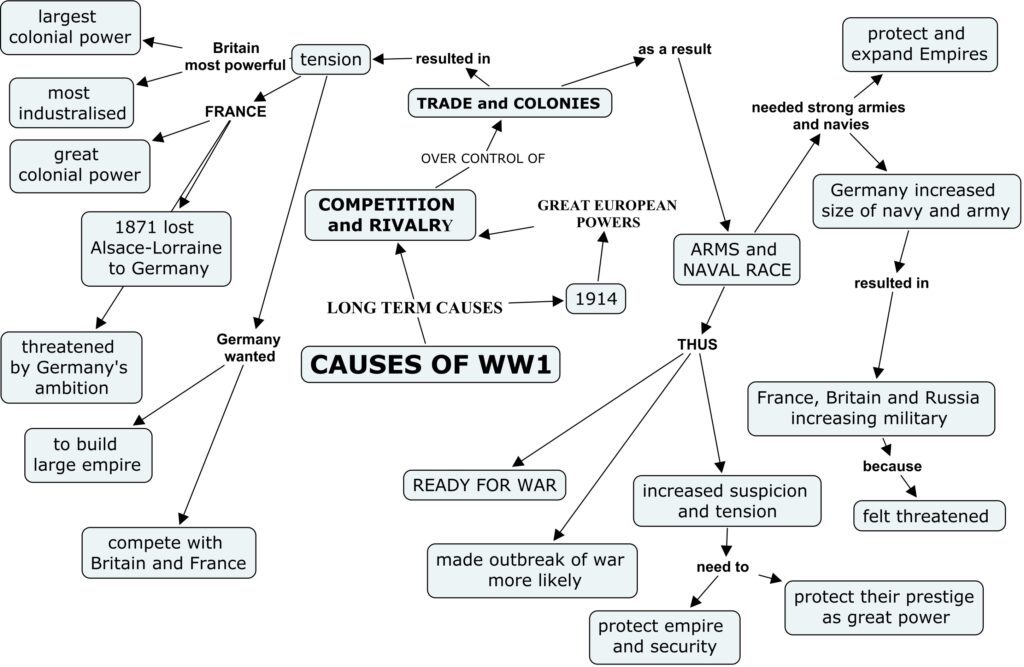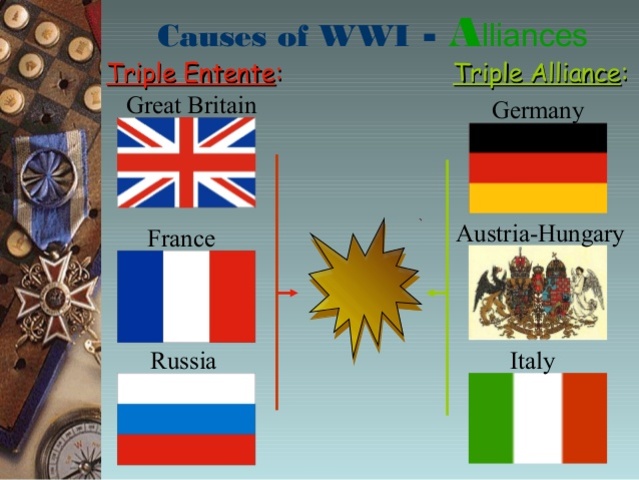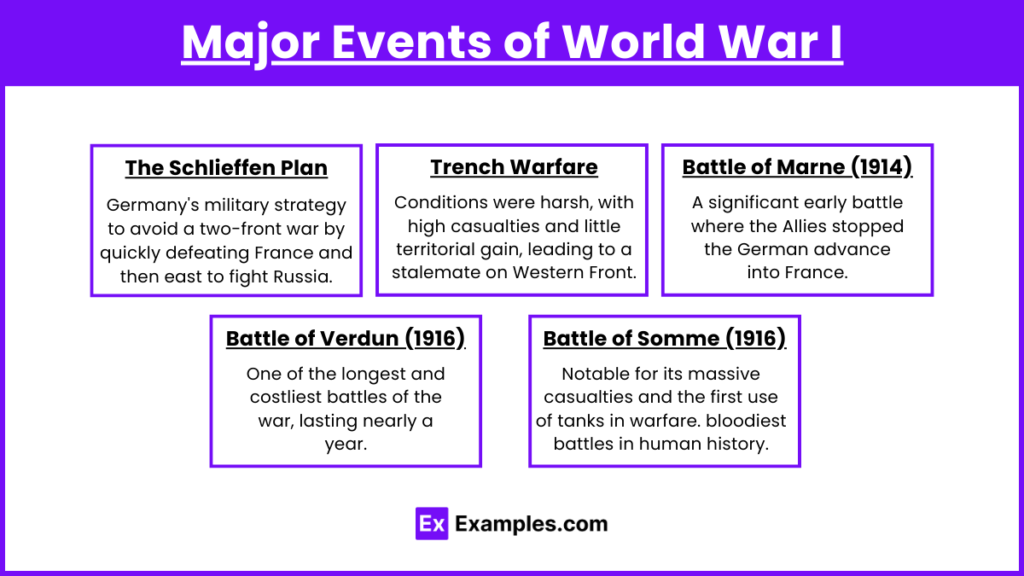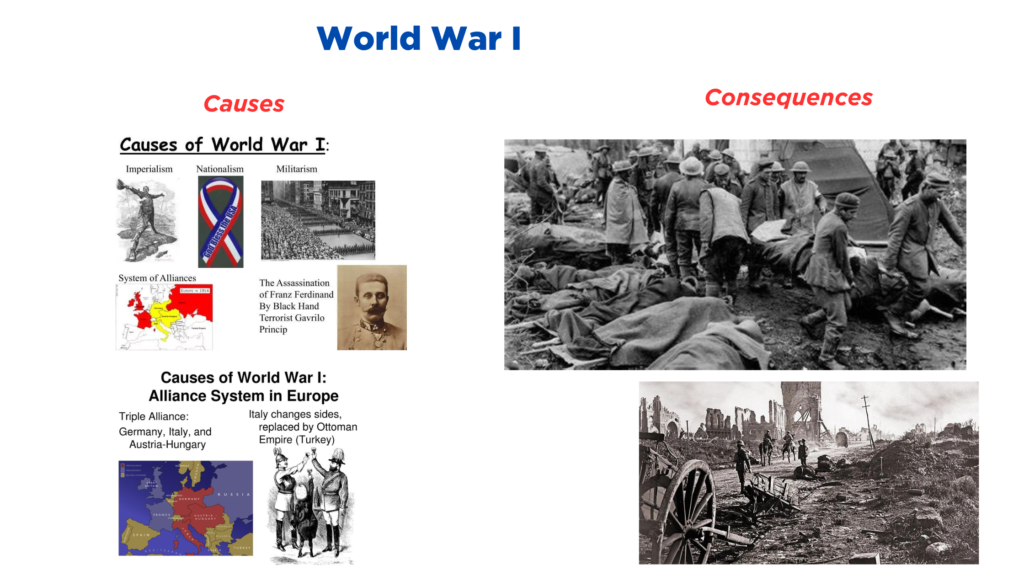World War I, also known as The Great War, was a pivotal conflict that shaped the 20th century. Spanning from 1914 to 1918, it involved most of the world’s great powers and resulted in an estimated 16 million deaths, reshaping the geopolitical landscape of Europe and the Middle East, and setting the stage for subsequent global conflicts. The war was not only a military struggle but also a clash of ideologies, technologies, and alliances. It marked the end of old empires, such as the Austro-Hungarian Empire, the Ottoman Empire, and the Russian Empire, and led to the emergence of new world powers. Despite being a war of unimaginable destruction, it catalyzed social, political, and economic transformations that reverberated throughout the century. This analysis explores the complex causes behind World War I, examines the key events during the conflict, and assesses the long-term consequences that continue to affect the global order today.
Causes of World War I

Nationalism
Nationalism was a powerful force in Europe in the early 20th century. National pride and the desire for independence and self-determination led to tensions between different ethnic groups within empires and between nations. This was particularly evident in the Balkans, where Slavic nationalism, particularly in Serbia, was a major catalyst. Nationalist sentiment led to desires for territorial expansion or independence, which became a source of friction between the Great Powers.
The assassination of Archduke Franz Ferdinand, heir to the Austro-Hungarian Empire, by a Serbian nationalist on June 28, 1914, acted as a spark that ignited these tensions. Austria-Hungary’s response to the assassination was emboldened by nationalism and led to the war’s outbreak.
Militarism
By the early 20th century, European nations had built up massive militaries. Militarism, the belief in maintaining strong military forces, led to an arms race, particularly between Germany and Britain. Each power sought to outdo the other in terms of technological advancements, fleet sizes, and army strength. The growing emphasis on military readiness made war seem inevitable and prepared European nations for a major conflict.
Militarism manifested itself in the Schrieffer Plan of Germany, which called for a rapid invasion of France through Belgium in the event of war. This plan, designed for a swift victory, would later backfire and contribute to the long and grueling nature of trench warfare.
Imperialism
The competition for colonies, particularly in Africa and Asia, heightened tensions between European powers. Germany, a latecomer to colonial expansion, felt excluded from the colonial privileges of Britain and France. This frustration at being left out of the imperial race added to growing rivalries, especially between these three nations. Conflicts over territorial control and resources around the globe were contributing factors that escalated tensions and laid the groundwork for war.
Alliances and Entanglements

The complex system of alliances in Europe added another layer of instability. The two major alliance blocs were:
The Triple Entente: France, Russia, and Britain.
The Triple Alliance: Germany, Austria-Hungary, and Italy (though Italy would later switch sides).
These alliances were meant to provide security, but they had the opposite effect, binding countries into commitments that would drag them into war. The alliance system meant that when Austria-Hungary declared war on Serbia, the conflict expanded rapidly as each country honored its military obligations, drawing in allies across Europe.
The Assassination of Archduke Franz Ferdinand
The assassination of Archduke Franz Ferdinand, the heir to the Austro-Hungarian throne, by Gavrilo Princip, a member of a Bosnian Serb nationalist group, is widely considered the immediate cause of the war. The assassination created a crisis that escalated as Austria-Hungary, with the backing of Germany, demanded harsh actions from Serbia. Serbia’s refusal led to Austria-Hungary declaring war on July 28, 1914, and the complex system of alliances triggered the involvement of other major powers.
Major Events of World War I

The Opening of the War
The war began in July 1914 when Austria-Hungary declared war on Serbia. Russia mobilized in defense of Serbia, and soon Germany declared war on Russia. France, allied with Russia, was dragged into the conflict, and when Germany invaded Belgium to attack France, Britain declared war on Germany. What began as a regional conflict in the Balkans quickly escalated into a world war.
The Western Front: Trench Warfare
The Western Front, stretching from the North Sea to Switzerland, became the epicenter of the war. The Schrieffer Plan aimed for a quick victory by attacking France through neutral Belgium, but this plan stalled. The war turned into a grueling stalemate, with both sides entrenched in elaborate defensive positions. Trench warfare, characterized by horrific conditions, barbed wire, and constant artillery bombardments, led to massive casualties. The Battle of the Somme (1916) and Verdun (1916) became symbols of the war’s brutality, where millions died in battles of attrition with little territorial gain.
The Eastern Front
The Eastern Front was less fortified and more fluid than the Western Front. Here, Germany and Austria-Hungary faced off against Russia. The Battle of Tannenberg (1914) marked a decisive victory for Germany, significantly weakening Russia. The Eastern Front saw large movements of troops and significant battles, but Russia’s internal instability, exacerbated by the war, eventually led to the Russian Revolution and the withdrawal of Russia from the conflict in 1917.
The War at Sea
The naval battle between Britain and Germany was crucial to the war effort. Britain’s Royal Navy imposed a blockade on Germany, restricting its access to vital resources. Germany responded by deploying submarines to target both military and civilian ships, including the Lusitania, which was sunk by a German U-boat in 1915, killing over 1,000 civilians, including 128 Americans. This event played a major role in pushing the United States toward entering the war.
The Entry of the United States
In April 1917, the United States, initially neutral, declared war on Germany. The primary motivations were Germany’s unrestricted submarine warfare, which threatened American shipping, and the interception of the Zimmerman Telegram, in which Germany sought an alliance with Mexico against the United States. The American entry into the war bolstered Allied forces with fresh troops and resources, significantly changing the balance of power.
The End of the War
By 1918, the Central Powers were exhausted, with many of their allies either defeated or in turmoil. The Allied Powers, supported by American resources, launched a final series of offensives, breaking through German lines. Germany, facing internal unrest and the collapse of its allies, sought an armistice, which was signed on November 11, 1918, effectively ending the war.
Consequences of World War I

Human Cost
World War I had a staggering human toll. Over 10 million soldiers and 7 million civilians perished, and many more were wounded, leaving lasting scars on entire generations. The war also led to widespread psychological trauma, with millions of soldiers suffering from shell shock, later recognized as PTSD.
The Collapse of Empires
The war caused the downfall of several empires:
The Austro-Hungarian Empire and the Ottoman Empire dissolved, leading to the creation of new nations.
The Russian Empire collapsed after the Russian Revolution of 1917, leading to the rise of the Soviet Union.
The German Empire was replaced by the Weimar Republic, and Germany faced severe penalties from the Treaty of Versailles.
The Treaty of Versailles
The Treaty of Versailles, signed in 1919, officially ended the war. The treaty imposed harsh reparations on Germany, forced it to relinquish territory, and severely limited its military capabilities. The treaty’s punitive terms sowed deep resentment in Germany, creating a fertile ground for the rise of Nazism and setting the stage for World War II.
The League of Nations
The League of Nations was established in the aftermath of the war in an attempt to prevent future conflicts. However, it lacked the authority and participation of major powers, including the United States, which did not ratify the treaty. The League proved ineffective in stopping the aggression of nations in the years leading up to World War II.
Social and Economic Changes
World War I had a profound effect on social structures. Women entered the workforce in unprecedented numbers to fill roles vacated by men who went to war. The war also left deep economic scars, particularly in Europe, where war debts and inflation plagued many nations. The war’s aftermath contributed to the Great Depression of the 1930s.
Conclusion
World War I was a trans formative and catastrophic event in world history. The war’s complex causes-rooted in nationalism, militarism, imperialism, and alliances-set the stage for a conflict that would involve much of the world and result in devastating consequences. The major battles and front lines, from the trenches of France to the naval engagements in the North Sea, became defining images of the war’s brutality. The war led to the collapse of empires, redrew national borders, and shifted global power dynamics, sowing the seeds for future conflicts, particularly World War II. The consequences of World War I continue to affect the world today, in terms of geopolitics, international relations, and collective memory. The war highlighted the destructive power of modern industrial warfare, the fragility of peace, and the importance of international diplomacy and cooperation to prevent future global catastrophes.



2 thoughts on “WORLD WAR I: THE GREAT WAR THAT SHAPED MODERN HISTORY”